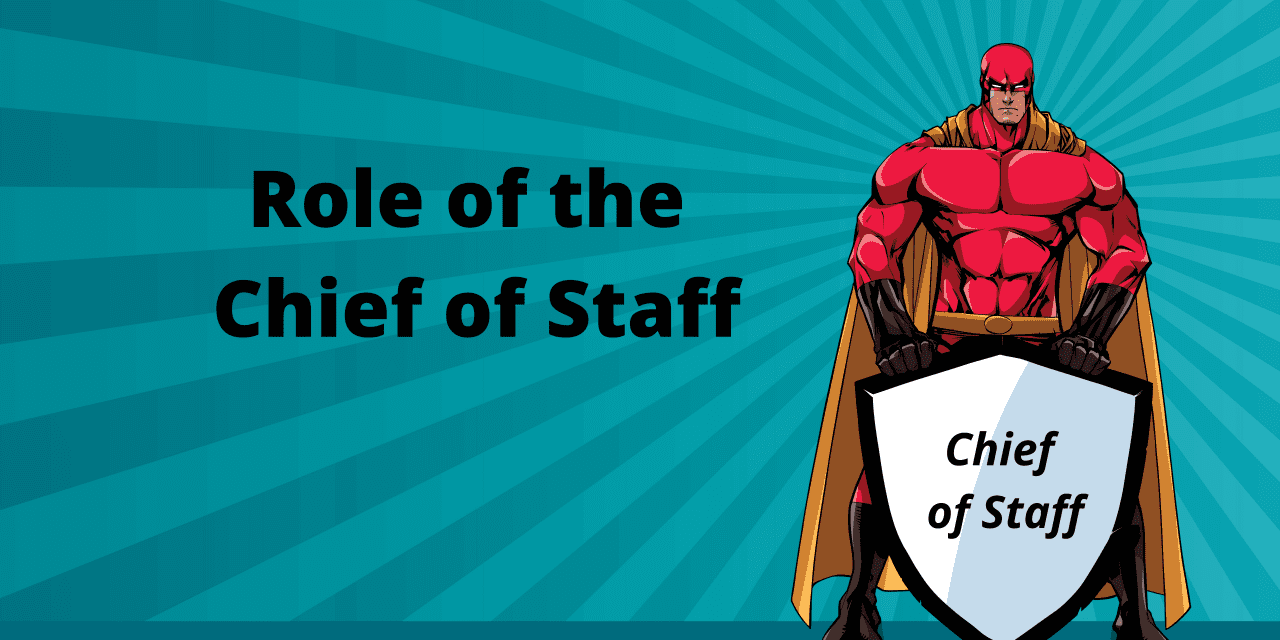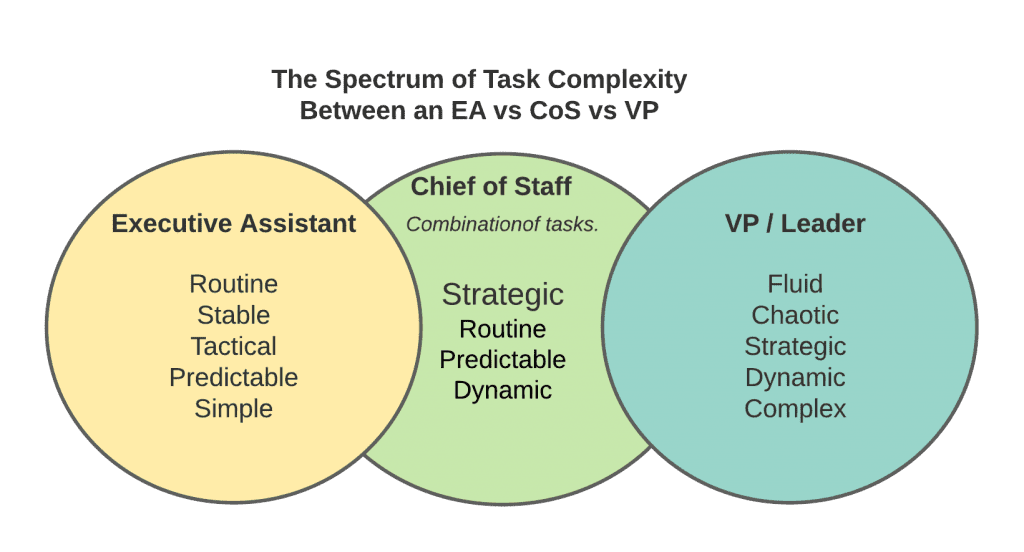Last updated on September 23rd, 2024 at 05:24 am
Over the last year and a half, I have been fortunate enough to serve as the ‘Chief of Staff’ (CoS) for a large technical organization. I have also been able to shadow various Chiefs of Staff within my company as well as at other tech organizations to understand their operation styles and see how they add value.
This post will look at the role from two perspectives; a) From the viewpoint of the leader/executive, b) From the viewpoint of the Chief of Staff.
This post will help the reader understand the need for a CoS, to design the roles and responsibilities of a CoS, and give you a comprehensive list of activities the CoS could possibly undertake.
Let’s start by discussing why leaders need a CoS. Similar to how software systems need to scale from being able to handle a thousand users to millions of users, leaders of large organizations need help to scale. Today’s executives have a myriad of things they need to juggle on a daily basis. From building new products, hiring, budgeting, operations, pricing, GTM strategies, building internal and external relationships, understanding competitive landscapes and so much more. The list is endless.
From a leader’s perspective, a support system is what helps you scale. Most leaders start with an Executive Assistant (EA). An EA takes care of the leader’s calendar, manages his/her time, and helps in scheduling meetings with other senior executives, etc. The EA handles more routine and simple tasks, that are stable, tactical. The Chief of Staff (CoS) is the natural next step in helping an executive scale.
There are instances where an executive/leader could possibly do without a CoS and still be able to scale. This is how most leaders with smaller teams manage, they start off having a super-efficient EA and heavily rely on them, and then they have senior leaders across all their business units/teams who can take things on. In this scenario, the org leader is effectively delegating some work to his senior leaders who are directly reporting to him/her to help the leader sale.
Leaders who handle organizations that are the size of tens of thousands of employees have a chief of staff in addition to a much larger support system. This would consist of having a CoS, a leader for special projects, operations, customer-centric individuals who could be deployed across the organization when and wherever needed. As a leader, you benefit by using a CoS to hand off some things that do not need your direct/constant attention. Think of someone who could take direction, do all the groundwork and bring it to your review rather than you having to be involved directly.
Why am I talking about this in a Technical Program Management (TPM) coaching blog? If you fundamentally look into what a TPM does -they help their SDMs or teams scale. The CoS also fundamentally does the same. Let’s think about this a little more; you really do not need a TPM if you only have a few devs and a dev manager.
Generally, you have TPMs who are managing either a) multiple teams or b) are laser-focused on a large initiative that is cross-functional. Similarly, a CoS is only needed for a team greater than 800 people or so, though that number is up for debate.
Many of the things I talk about below might sound overly familiar to a TPM and that is because being CoS is a role for someone who is looking for a new challenging journey to embark on. Though a TPM might be an organic transition to CoS, the role could also be filled by a Director or any other leadership role.
The CoS role is significantly reactive in nature. The role might involve long-term planning and strategy, but for the most bit, it is quite tactical as far as I have observed. This could depend on the organization and industry. It is a challenging role for someone with exceptional people skills, exceptional organizational skills, and a high degree of emotional intelligence.
Therefore as a TPM, you could assess your leader needs and pitch the CoS role to help them scale 🙂
1. Why A Leader Needs a Chief of Staff
- Every individual has blind spots… things that they might need help with. A CoS could help in bridging that gap.
- Be the proxy for a leader, allowing them to be at multiple places at the same time.
- A CoS could also be used to help out with administrative things like approving budgets, expenses, etc. where the overarching guiding principles have already been decided by the leader. The leader could monitor the budget but the day-to-day management would be done by the Chief of Staff.
- A CoS could act as a coach and someone to use as a sounding board for ideas.
- A CoS is most beneficial when a business/organization is going through a growth spurt or is in a mode of iterative evolution, which is the case in most tech companies.
- When you have a new leader coming into an existing org. A CoS helps them ramp up quickly and gives them the lay of the land.
- Gives the leader the ability to prioritize their time by delegating.
- Handle escalations for a leader while keeping them informed versus having to be directly involved.
2. The Chief of Staff’s Roles & Responsibilities
I have split this into five categories.
- Tactical: handle daily workings.
- Strategic: keep in mind long term objectives.
- Special Projects: lead projects/programs that would make or break an organization, these are big bets the org is taking on.
- Cadence Meetings: manage not only the rhythm of these meetings but also craft the agenda, flow, and the content that needs to be shared in each of these meetings.
- Miscellaneous: A catch-all category.
2.1 Tactical Responsibilities
Drive followups for both internal and external action items that the leader cares about.
- Facilitation of programs vs Owning/Running Programs.
- Provides opinions, analyses, recommendations to the leader when needed.
- Manages the leader’s communications, brand, and social media.
- Acts As A Proxy For The Leader:
– Facilitate cross-departmental decision making and tactfully represents the Leader when needed.
– Stands in when the leader is out of the office or is attending to other urgent issues.
– Assist in communicating and clarifying important messages for a geographically dispersed team or larger organizations.
– Preemptively take the temperature of high conflict situations by having exploratory meetings before the leaders get started. This should ensure the leader is not blindsided by people’s stand on things and the situation is not too arduous to diffuse.
2.2 Strategic:
Anticipates risks in programs and prepare plans A, B, and C.
- Fill gaps in leadership structure when there is attrition in the organization.
- Help the organization interpret, understand the asks, and the strategic vision of the leader.
- Exercises exceptional judgment and discretion in dealing with confidential information.
- Acts as a thought partner to help the leader bounce ideas and as a coach and confidant when needed.
- Digests and summarizes quantitive and qualitative data related to markets, technologies, projects, budgets, pricing, re-orgs, etc.
2.3 Special Projects
Owning a project that would make or break the org/company. This happens often and would be an additional responsibility for the CoS.
Examples of special projects:
- Revamping Executive compensation.
- Restructuring the organization.
- Review specific mergers and acquisition opportunities.
- Revamping organizational operational, budgeting, and planning processes as the organization continues to evolve.
- Owning Diversity & Inclusion Programs.
2.4 Cadence/Rhythm Meetings
- Weekly or bi-weekly staff meetings.
- Org-All Hands Meetings.
- Morale & Team Building events for the team.
- Monthly / Quarterly Product Roadmap Reviews.
- Monthly / Quarterly Business & Operational reviews.
- Staff Meetings with the leader’s directs.
- Internal and external presentations & higher executive reporting.
- Ad-hoc program/product reviews.
The CoS is responsible for the cadence and rhythm of these meetings, but more importantly, keeps track of what needs to be brought to the leader’s attention, the various action items and follow-up that comes out of each of these meetings.
2.5 Miscellaneous
- The CoS understands what keeps the leader up at night and tries to solve those problems. I always ask my leader ‘what is worrying you the most and what can I do about it for you?
- Negotiating, fire fighting, public speaking, building relationships, managing budgets, looking into operations, and attending to other miscellaneous tasks.
- A CoS needs to wear many hats and reduce the load on the leader they support.
- Understand “Primary vs Secondary Function”
– Primary function: You serve your leader.
– Secondary Function: You serve your leader’s team.
3. Key Competencies For A Chief of Staff
A CoS is often not proficient in everything he or she is expected to do. So there will be failures. The key here is to accept that we try to do our best and if we fail we learn from failure and move on to fight another day.
I have split ‘Key Competencies for a CoS’ into four categories.
- Core Competencies
- Servant Leader
- Organizational
- Program Management
3.1 Core Competencies:
- Results-oriented: Manage work and measure success.
- Process & Structure: Understand organizational working and implement the right controls and processes.
- Visionary: Ability to think ahead, and see what’s coming by connecting the dots.
- Political Savvy: Building relationships and being able to adeptly operate.
- Coach: The ability to coach not only the leader you serve but also their directs.
3.2 Servant Leader:
As a CoS, you are a servant-leader and your number one goal is to ensure that your leader is doing well and you are enabling them to maximize their potential.
- The CoS must represent the leader but also remember that they are NOT the leader.
- Be selfless- what you want is secondary to what your leader and the organization needs from you.
- You must embody the values of your leader and your organization. This is critical as a CoS holds the highest office, only second to the leader. People around you will see you and will pick up behaviors from you.
- Remember the difference between a servant-leader and servitude. A CoS will need to find that elusive balance between being a servant vs being an aspiring leader who adds value.
- Manage without ego.
3.3 Organizational
- High degree of emotional intelligence
- Exceptional flexibility to adapt to situations.
- A hustler of sorts. Most successful CoS are able to adapt to any situation and are superbly resourceful.
- Able to identify key people across the organization and build relationships that can help the CoS keep his/her ear to the ground.
3.4 Program Management
- The ability to bring in the ‘Activation Energy‘ to new programs. I have generally observed that most CoS have incredible enthusiasm with the uncanny ability to quickly figure out what needs to be done, put frameworks in place, and kick-off programs to set up teams for success.
- Have a track record of being a high performing individual and getting stuff done.
- Being accurate is a necessity. Decisions are taken on the data, reports, and metrics a CoS provides. It’s absolutely necessary to ensure that the information is trustworthy.
- When proxying for individuals (your leader or someone else), the CoS has to precisely articulate their stand on things and not misrepresent them.
- Concise communication is absolutely necessary. A CoS should be able to articulate complex ideas with the right degree of detail for the audience.
See also: The Power of Crafting Your Performance Summary
4. Designing & Hiring For The CoS Role
- As a leader, understanding your needs and hiring accordingly is key. If you do not carefully craft the role and the responsibilities of your Chief of Staff the role, it can be seen as a wedge between the leader and the organization.
- Understand the two models:-
Complementary Model: The CoS is complementing the strengths of his/her leader. (Most Common)
Supplementary Model: At times CoS is hired for his/her experience running certain types of projects when you or your team is lacking a specific skill set. - The CoS role can be designed as a landing pad for senior executives in the company who have significant knowhow, skill, relationships but are not vying for the top spot or do not want a team directly reporting to them.
- Other things to consider:-
– Role Duration: Long term vs Short term role
– Level & Rank of your CoS
– CoS Generalist vs Specialist
Advanced Reading Recommendations:-
Books:
- Chief Of Staff: The Strategic Partner Who Will Revolutionize Your Organization
- Riding Shotgun: The Role of the COO, Updated Edition
- How to be a Chief Operating Officer: 16 Disciplines for Success
Blogs:
- The Chief of Staff role in Silicon Valley
- I’ve Logged 10,000 Hours as a Chief of Staff in a Large Tech Company
- The Case for a Chief of Staff
- Become a Chief of Staff with Brian Rumao (Video)
- The Chief of Staff (Podcast)
- TPM Blog for coaching
Jobs: Check out Chief of Staff Opportunities
Further reading: Guide to Hiring your Chief of Staff
Resources Available:
- Chief of Staff Charter
- Chief of Staff Job Descriptions
Reach out to me on LinkedIn for the above resources or guidance in setting up a Chief of Staff to help you scale.
Resources:
- https://hbr.org/2020/05/the-case-for-a-chief-of-staff
- https://docs.google.com/presentation/d/1lCYx08sFITq6uGnSDSBH0qfNFh_kiCWkk7vn22W6TRQ/mobilepresent?slide=id.g1edd8bfa32e_0_697
- https://askachiefofstaff.substack.com/
Thanks for reading and I hope this was helpful!
Ready to level up your TPM Career?
Unlock your potential as a TPM—master the fundamentals, navigate career levels, and excel in your role.



















Interesting post. As a management consultant (originally from Europe) I’ve been able to see lots of different businesses across the world. The chief of staff role is definitely a big help in increasing a leader’s bandwidth. It’s also a role that is far more common in the USA than other countries where I’ve worked. In fact, during mergers I’ve noted shock on the faces of some European IT leaders when they see that their US peers, and even a level lower, have a CoS.
The CoS role is also a good career option. It provides exposure to large swathes of a business; far more than any other role besides leadership. In doing so it also provides the CoS with exposure to senior management across the business, raising their profile. Consequently, assuming a good relationship with the boss, a CoS has a huge advantage over other internal candidates for jobs.
In some ways being a CoS is like being a child whose parent is grooming him or her to take over responsibility for the family business. Promotion is just assumed.
But there are dangers. In particular, sniping by former peers who may see the CoS as a “favored child.”